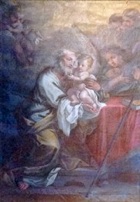

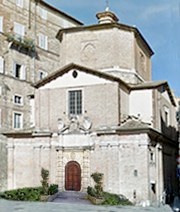
The Compagnia dell’ Orazione e della Buona Morte was formed in 1570 by sixteen pious Perugians in order to promote prayers (orazione) before the Eucharist and to provide a decent burial for people who had died in poverty, who would otherwise be buried in unconsecrated ground. (It was modelled on the Arciconfraternita di Santa Maria dell' Orazione e Morte, which had been formed in Rome in 1538 with the aim of burying the bodies that were then commonly found in the countryside around the city).
The Compagnia della Morte originally held its meetings at the church of the Maestà delle Volte. It bought properties in what is now Piazza Piccinino that it bought from Annibale Ranieri in 1574 in order to build its own church. It commissioned a design from Vincenzo Danti in 1575, but he died in the following year and the commission was transferred to Bino Sozi. [Could this design in the Cooper-Hewitt National Design Museum of the Smithsonian Institute, Washington, which is signed “Bino Sotij nel primo offitio 1573” and relates to the addition of chapels to an octagonal church, relate to the Chiesa della Morte ??] Construction was halted on a number of occasions due to lack of funds, and the confraternity was unable to move here until 1603. In its last meeting before moving, it decided that the new church should be dedicated as Ogni Santi (All Saints).
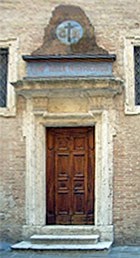

Pope Paul V approved the Perugian confraternity and subordinated it to the confraternity in Rome in 1606. Its constitution was formally approved by Bishop Napoleone Comitoli and Cardinal Bevilacqua in 1618.
The church is in the form of a Greek cross and a high cupola. In this website on the restoration by Antonio de Feo Restauri in 2005, it is suggested that the heavy brick cladding of the cupola was not envisaged in the original design.
Interior
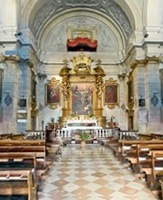
The interior has an square floor plan with a rectangular tribune and two rectangular side chapels. There is a balustraded choir above the entrance. The organ (1897) was built by Nicolò and Francesco Morettini.
Inscriptions near the high altar record:
-
✴its consecration in 1575 by Bishop Francesco Bossi; and
-
✴its reconsecration in 1741 by Bishop Francesco Riccardo Ferniani.
Virgin Interceding for Souls in Purgatory (1612)
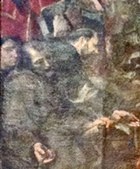
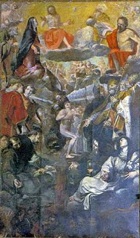
Vincenzo Alessi, who was the Archpriest of the Duomo and who met most of the cost of the construction of the high altar, also commissioned its altarpiece from Vincenzo Pellegrini. Monsignor Fulvio Paolucci, the first guardian of the confraternity, blessed it before it was brought here in procession to be installed. It was finished just six months before Vincenzo Pellegrini was murdered, and is his last known work. (He was subsequently buried in the church).
In the upper part of the panel, the Virgin appears before the figures of the Trinity, while St John the Baptist, to the right, looks down on souls in purgatory. These souls are surrounded by a large number of saints, a reference to the original dedication of the church to Ogni Santi (all saints). They include SS Dominic and Francis: as can be seen in the detail illustrated to the left, the latter holds his cord, representing poverty, towards the dead souls as a route to redemption. The man at the extreme left who looks down over the shoulder of St Francis at the souls in purgatory, is perhaps a self-portrait of Vincenzo Pellegrini: it might have been prescient, or it might have been added after his death.
St Joseph and the baby Jesus (18th century)
Panels (18th century)
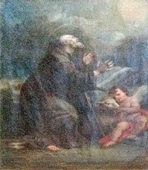
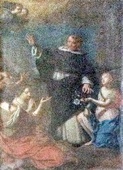
The following panels are attributed to Cristoforo Gasperi:
-
✴St Francis and an angel (on the right wall of the chapel on the left); and
-
✴St Vincent Ferrer preaching (to the right of the crucifix above the altar of this chapel).
Panels (18th century)
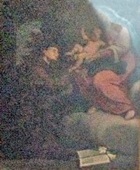
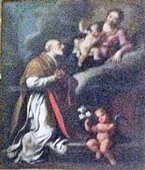
The following panels are attributed to Francesco Busti:
-
✴St Antony of Padua’s vision of the Madonna and Child (on the right wall of the chapel on the right); and
-
✴St Philip Neri’s vision of the Madonna and Child (on the left wall of the chapel on the left).
Read more:
G. Cerbini, “Le Parrocchie dei Santi Lucia e Andrea con Note Storiche sulla Compagnia dell' Orazione e della Morte in Perugia”, (1988) Perugia
Return to Monuments of Perugia.
Return to Walk VI.
